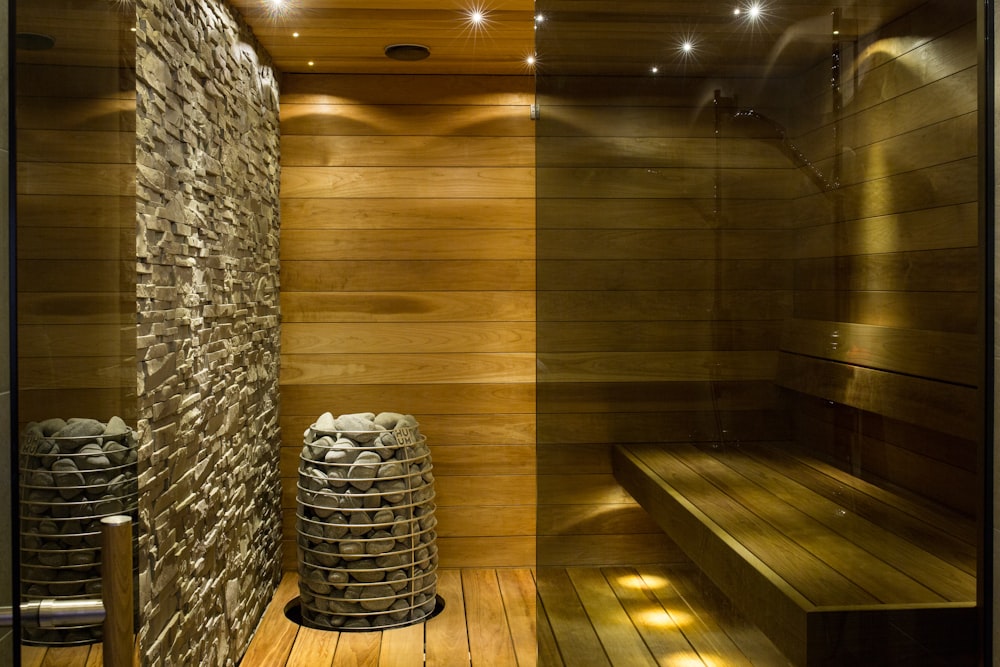Improve Recovery, Performance and Health with the Sauna
Do you want to improve your cycling performance, recover faster between rides, or maintain muscle while recovering from an injury?
By using the sauna, you can accomplish each of these and much more. The benefits of using the sauna are wide-ranging and impact various facets of health, including both physical and mental.
Frequent sauna users can expect to see benefits manifest in some of the following ways:
- Increased endurance
- Heat acclimatization
- Muscle mass and endurance maintenance
- Better cardiovascular health (blood pressure & cholesterol)
- Improved hormonal health, including insulin control
- Cognitive health boosts and treatment of depression
- Detoxification
In this article, you will learn how the sauna works as we take a deeper look at the benefits and the science that backs them up.
If you are interested in learning more about recovery and injury prevention for cycling, check out our in-depth article.
Table of Contents
1. Performance & Fitness Benefits
2. Mental & Physical Health Benefits
4. Fluid & Electrolyte Replenishment
5. FAQ
1. Performance & Fitness Benefits
Many cyclists seek an edge in performance, whether in a competitive setting or just amongst friends.
While nothing can replace time in the saddle to build performance and fitness for riding, the sauna can further benefit endurance and fitness on rest days or following a ride.
It’s also worth noting that studies on sauna use have shown enhanced endurance in highly-trained and untrained people.
Heat acclimatization
While exercising, your body’s core temperature gradually rises. This temperature increase is helpful to a certain point, improving blood flow and muscle function. However, as it becomes too high, your endurance begins to decline, and you begin to experience exhaustion.
One of the body’s defense mechanisms manifests as a decline in performance as core temperature rises. It prevents you from over-exerting yourself and then overheating, which can be fatal in extreme cases.
You can see this play out in professional cycling. Racers open their jerseys to cool down when they start overheating, despite negatively impacting aerodynamics by having a jersey flapping in the wind.
Heat acclimatization, such as through sauna use, dramatically improves your body’s ability to regulate heat. This acclimatization reduces the physical strain you perceive when overheating during a ride, optimizing the body for future exercise, especially in hot environments.
Becoming more heat-acclimated also means that sweating will begin at a lower core body temperature which adds to your body’s ability to maintain an optimal core temperature for longer.
Endurance Benefits & Maintenance
Regular sauna use is repeatedly linked with significant increases in baseline fitness.
In a 2007 study out of the University of Otago, New Zealand, sauna use post-exercise was shown to increase runners’ time to exhaustion by 32%. The participants used the sauna twice weekly for three weeks, spending 30 minutes each session.
Another study published in 2020 in the European Journal of Applied Physiology found that post-exercise sauna use increases VO2max by 8%, running speed by 4%, and time to exhaustion by 12%.
The body’s response to sauna bathing is similar to moderate to high-intensity exercise. For example, in medium heat saunas, the heart rate can increase to 120+ beats per minute (bpm), increasing to 160bpm in hotter saunas.
Furthermore, sauna use is recommended as an alternative to exercise for individuals who cannot engage in aerobic activity due to chronic illness or physical impairment. Frequent use may help these individuals increase and maintain aerobic fitness.
Muscle mass maintenance

Muscle wasting is the loss of muscle tissue that occurs when a person becomes immobilized due to injury or illness. This is more common among older adults and persons who sustain significant injuries that require bed rest.
Within just one week of being unable to use your muscles, considerable strength losses occur. Most cyclists have experienced this problem when sidelined due to an injury or crash. Within just two weeks of inactivity, it can feel like you have lost all of the fitness that took months to build up.
The good news is, the sauna may help you maintain a lot of that muscle mass and fitness, while also helping to regain those losses faster once you are back exercising again.
A 2019 study by researchers from the American College of Sports Medicine demonstrated this using daily heat treatments on patients immobilized for 10 days. The heat treatment prevented the loss of mitochondrial function (responsible for energy production in your cells) and slowed muscle wasting by 37%.
In addition, University of Florida researchers demonstrated that after a week of immobilization, using heat therapy paired with exercise can increase muscle regrowth by 30% compared to those who just begin exercising again.
2. Overall Mental & Physical Health Benefits
Cardiovascular Health – Blood Pressure & Cholesterol
During a sauna session your heart rate and blood pressure increase (as with exercise). Once you leave the sauna, blood pressure and heart rate drop to below baseline levels pre-sauna (or pre-exercise).
This results in improvements to high blood pressure (hypertension) as has been shown in one study. From that research, sauna use between two to seven times per week resulted in a 24 – 46 percent lower risk of developing hypertension.
The cholesterol-lowering effects of the sauna are another key component to improving cardiovascular health. Regular sauna use (3+ times per week) in both men and women lowers blood cholesterol levels.
The combination of these benefits along with other positive effects has been demonstrated repeatedly. A long-term study of 2,315 men in Finland showed that those who use the sauna four to seven times per week are up to 52% less likely to die from cardiovascular-related issues compared to those who use the sauna once per week.
Furthermore, frequent sauna use is shown to lower the risk of dying from all causes of premature death by up to 40%. The study demonstrated this regardless of age, activity levels, and other lifestyle factors that might have influenced the participants’ health.
Insulin Control
Diabetes affects 10% of Americans, with an estimated 33% having prediabetes. Type-2 diabetes is generally associated with negative lifestyle choices like inactivity and poor nutrition.
Frequent sauna use has been shown to reverse some of the negative effects associated with these lifestyle choices, including insulin sensitivity and blood glucose levels. Researchers from the University of Medicine in Japan demonstrated these results in diabetic mice, which may have implications for diabetes treatment following further research in the future.
Cognitive Health & Depression
Sauna, like exercise, can have various beneficial effects on brain health and mental health for frequent users.
Alzheimer’s disease is a problem that is characterized by a rapid cognitive decline in older adults. An estimated 10% of people over the age of 65 in the US have Alzheimer’s.
From the same large study mentioned above that took place in Finland, researchers note that using the sauna four to seven times per week is associated with a 65% lower risk of developing Alzheimer’s, compared to the men in the study who used the sauna just once per week.
Depression is another huge issue in today’s society. 18% of people in the USA over the age of 18 suffer from depression. Exercise is commonly prescribed as a means to tackle the symptoms of depression. The sauna is also showing promising signs due to the exercise-like effects on the body.
In 2016, researchers at the University of Wisconsin carried out a clinical trial on 30 healthy adults with depression. They showed that after one whole-body heat therapy session, participants experienced a significant antidepressant effect that lasted up to six weeks afterward.
Detoxification
There are many elements of the modern environment that can be toxic if we are over-exposed to them. This includes BPA in plastics, heavy metals found in agricultural products, automobile fumes, kids’ toys, and even some types of fish.
The good news is that sweating helps the body detoxify and remove some of these toxins. By using the sauna, an average person loses on average 1.1lbs of sweat.
The sauna is commonly used as a treatment for heavy metal exposure and it may become a common treatment for many kinds of environmental contaminants.
3. When to Avoid the Sauna?
Sauna use is safe for most adults and can be done before or after exercise to boost the beneficial effects of the exercise.
However, the following groups should avoid the sauna:
- Pregnant women
- People with cardiovascular conditions
- Children
- Anyone who is ill or taking medication
Before using the sauna, consult with your doctor to ensure you are not in an at-risk group.
Do not consume alcohol before or during the sauna. It is dangerous and can cause severe health problems.
4. Fluid & Electrolyte Replenishment
Most cyclists have experience with maintaining a healthy balance of fluids and electrolytes from riding. You should use the same healthy practices to ensure you are hydrated properly if you plan to use the sauna.
As mentioned above, the average person loses 1.1lbs of fluid through sweat in a single sauna session. Many of the body’s vital electrolytes are lost in this sweat, like with exercise.
If you use the sauna, drink plenty of fluids before and after the session. You should also consume electrolyte-rich foods or an electrolyte supplement. Examples of these foods include spinach, avocado, tomatoes, fish, nuts, and seeds.
For more information on nutrition and hydration for cycling, check out our article here.
Conclusion
Looking at the research, it is clear that the sauna can be beneficial for cyclists. It can help you maintain fitness and muscle while recovering from an injury, boost your performance on the bike, and improve your overall health.
When you use the sauna in combination with aerobic exercise like cycling, the benefits are compounded. Research has shown that people with good cardiovascular fitness who use the sauna experience greater benefits than those with low cardiovascular fitness.
Make sure to check with your primary care doctor before trying the sauna, to ensure it will not interact with any underlying illness. All that’s left to do now is to go and check out the benefits for yourself!
FAQ
What is the sauna?
Sauna, and sauna-like practices like sweat lodges, are common in many cultures around the world, such as various Native American tribes, Scandinavian countries, Russia, and Turkey.
Sauna use is essentially bathing oneself in heat for healing, purification, cleansing by short-term, passive exposure.
The saunas we are familiar with in western countries can vary quite a bit. Due to their different heat sources, size, and structure, the temperature and humidity vary significantly.
What does a typical sauna session look like?
The temperature and humidity of your sauna will determine the length of the session. Most saunas have a thermometer on the wall or close to the temperature control panel.
Typical modern electric saunas should heat the air to between approximately 158°F to 212°F, while infrared heaters work to slightly lower temperatures of 113°F to 140°F.
For hotter saunas, a typical session will be 15-25 minutes. For lower temperatures, longer sessions of 30+ minutes are necessary to experience the same benefits.
What does the sauna do that results in these benefits?
Use of the sauna results in mild hyperthermia (overheating). This controlled overheating stimulates a wide array of positive responses in the body, very similar to those experienced during moderate-intensity exercise.
These responses boost performance, help activate your body’s defense systems and reduce inflammation, protecting you against many diseases.
The results from a 2017 study suggest that just two or three 20 minute sauna sessions per week reduce the risk of developing certain diseases including respiratory illnesses like pneumonia. These findings make the sauna very relevant in a post-pandemic world.
Read Next
Cycling Knee Pain — Understanding and Fixing the Most Common Causes
Saddle Sores from Cycling: What Causes Them & How to Prevent and Treat Them





